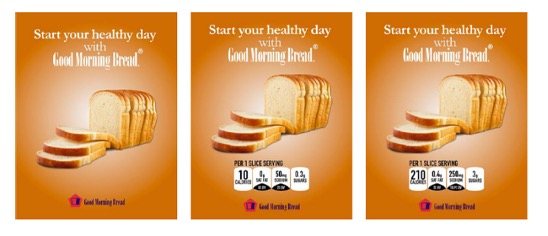The Surprising Impact of Front-of-Package Labels of Food Ads on Consumer Behavior
Relevant topics Archive, Advertising
It’s Saturday night and you’re watching your favorite show. As the show reaches a thrilling climax, it cuts to a commercial break, and that is when your eyes catch something extraordinary. You come across a mouthwatering food ad that stands out from the rest. The perfectly plated dish looks incredibly delicious. However as a health-conscious individual, you are curious about the nutritional information of this tempting meal.
Information is key
A group of researchers recognised the convenience and effectiveness of front-of-package labels in helping consumers quickly understand the nutritional content of products. These labels, usually found on food packaging, provide key information such as calories, fat content, sugar content, and other important details. These innovative researchers decided to take this concept and explore whether the same idea can be applied to food advertisements online. Imagine seeing that mouthwatering food ad, and right next to it, a clear and easy-to-understand front-of-package label displaying its nutritional value.
The study aimed to determine if providing nutritional information directly on food print advertisements online could influence consumer behavior. By adding these informative labels into the ads, the researchers hoped to empower people to make better-informed food choices. This, in turn, could lead to healthier eating habits, as individuals would have the opportunity to assess the nutritional value of the meals before deciding whether to indulge in them.

Labels and Positive Vibes
Results showed that having a front-of-package label on a food ad really makes a difference in how people perceive the product and the ad itself. It's like this label brings a whole new level of positive vibes to the ad!
When the label includes information about healthier nutrient content, people responded super positively. They felt that the product was healthier, had a better attitude towards the ad and the brand, and even thought the brand had a healthier image. Plus, they were more likely to want to buy the product! How awesome is that?
But here's the cool part: even if the product was not that healthy, just having that front-of-package label increased the perception of healthfulness in people's minds. So, it seems like showing any nutrition information on the label is better than hiding it, and it makes the ad way more effective overall.
Interestingly though the amount of nutrient content listed on the label didn't have a huge impact on purchase intention. It's like people didn't pay much attention to that specific detail when deciding whether to buy the product or not.
How can I use front-of-package labels in my food ads?
If you’re in the food advertisement industry, there are so many implications from this study that could supercharge your advertising game!
The first big takeaway is that front-of-package labels can be a game-changer in food print advertisements (even if the product isn't the healthiest!). This study suggests that adding those informative labels to your ads can have a significant impact on how customers perceive the product and the ad itself. It creates positive vibes and makes people more likely to think the product is healthier and have a better attitude towards the ad and the brand. That's some powerful stuff!
Even when the product isn't super healthy, just having that front-of-package label still boosts the perception of healthfulness. It's like people appreciate having access to nutritional information, no matter what. So, as a marketer, don't shy away from using the label, even for less healthy products. It can still make your ads way more effective overall.
The study also found that the amount of nutrient content listed on the label didn't have a huge impact on purchase intention. So, while it's essential to provide the necessary information, don't stress too much about showing every single detail. Focus on delivering the key nutrition facts that matter most to your audience.
When launching a new food product, this study suggests that your advertising strategy should focus on using the front-of-package label as a key message cue. It's like a signal to consumers that the ad, brand, and product are worth checking out. It can help increase brand awareness and knowledge about the product, which is crucial in the early stages of a launch.
Some food for thought
Although, here is some food for thought, this study does come with some limitations. The thinking abilities in the experiment were kept simple, with just five basic bits of nutrition info on the label. But, in the real world, things can get way more complex, and if a label overwhelms consumers with too much data, it could backfire with negative responses. So we can take home that front labels should be kept digestible.
The study also only focused on one product category, which means we can’t go spreading these findings across the board. To create more comprehensive results, we need to test various product categories.
Talking about variety, it seems that they only focused on a fictional bread product for their research. But let’s face it, different foods cater to different cravings. Imagine using the same label for bread as a refreshing can of Coke. So bare this in mind if you are considering adapting your front-of-package label on pleasurable foods, as these studies results seem to based on enriched food ads. It would be cool for future studies to see how the flavors of effectiveness differ in enriched and pleasurable food ads.
Further Reading
-
The Power of Fonts: How Typeface Can Influence Charitable Behavior and Boost Donations
Did you know that the font you use can have a huge impact on how people perceive your brand? It's true!
In today’s competitive world of branding and marketing, brands are always on the lookout for new and innovative ways to connect with their audience. Believe it or not, one strategy that has emerged as particularly effective is typeface design. That’s right, fonts can be a powerful tool in promoting a cause and building a brand’s reputation.
In this blog post, we'll dive into the science behind the use of handwritten typefaces, and how it can create a sense of interpersonal connectedness that leads to charitable behavior. We'll also provide practical tips on how to choose the right typeface for your brand and more. Whether you're a non-profit organization or a luxury brand, this post will show you how to leverage the power of fonts to create a stronger and more effective marketing campaign. So, are you curious to learn more about how the right font can make a big difference?


